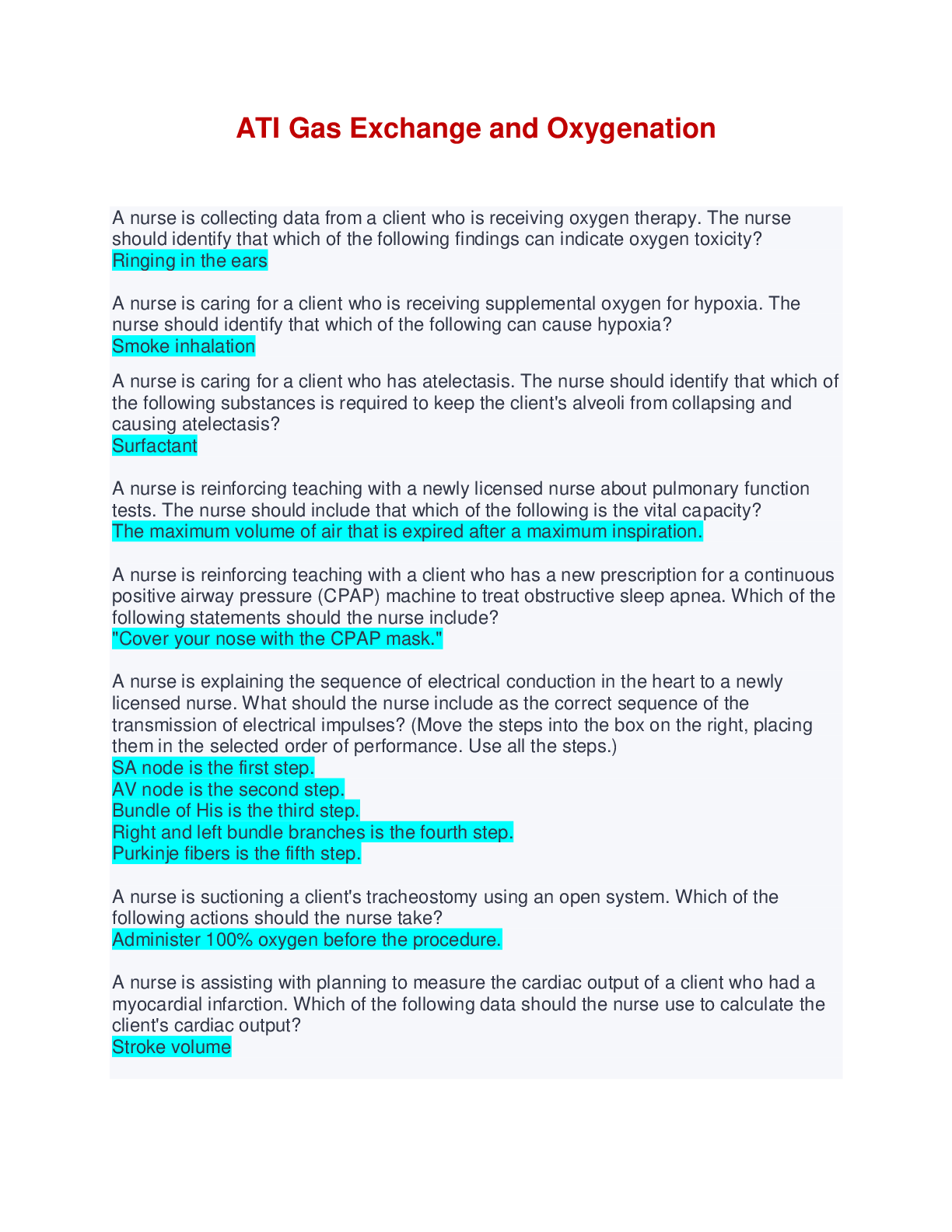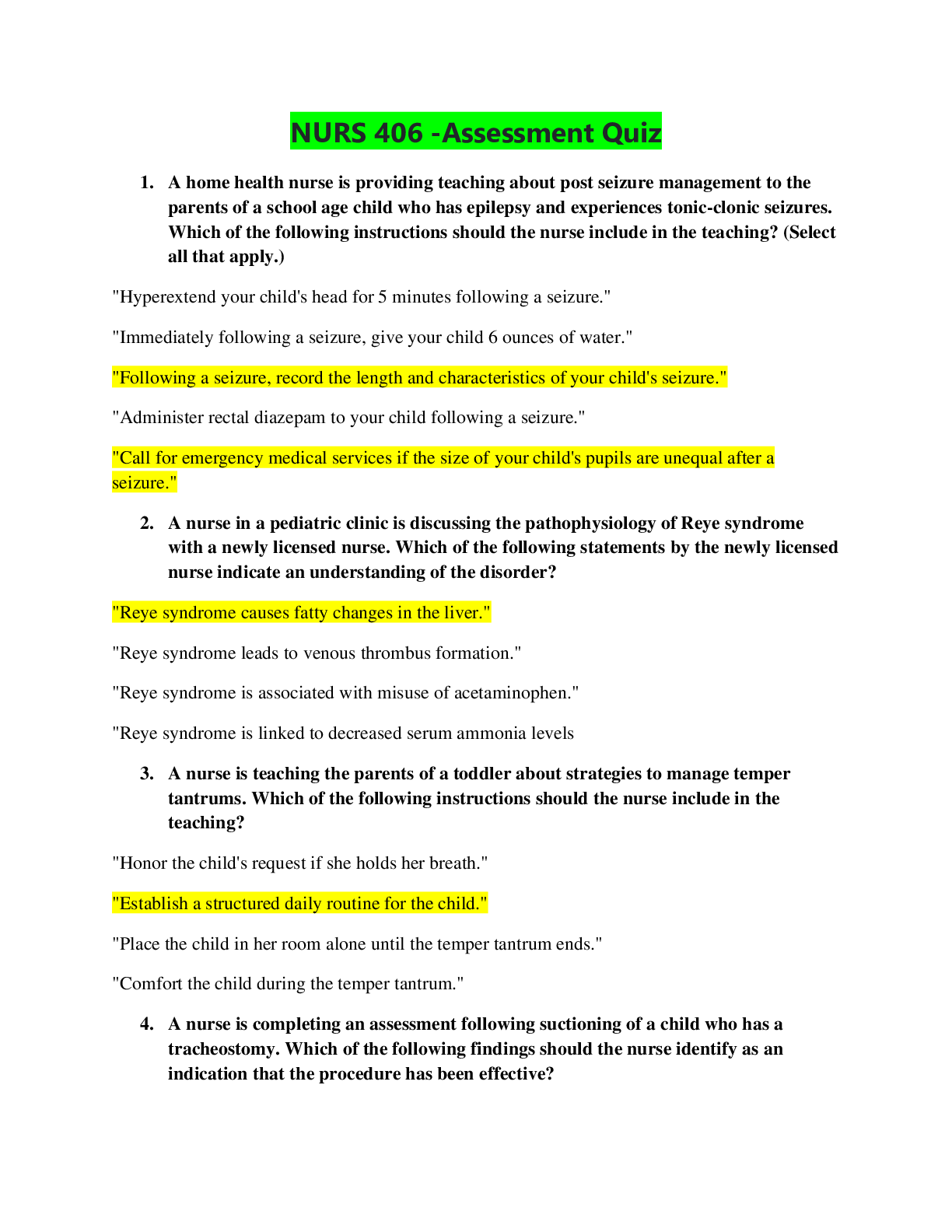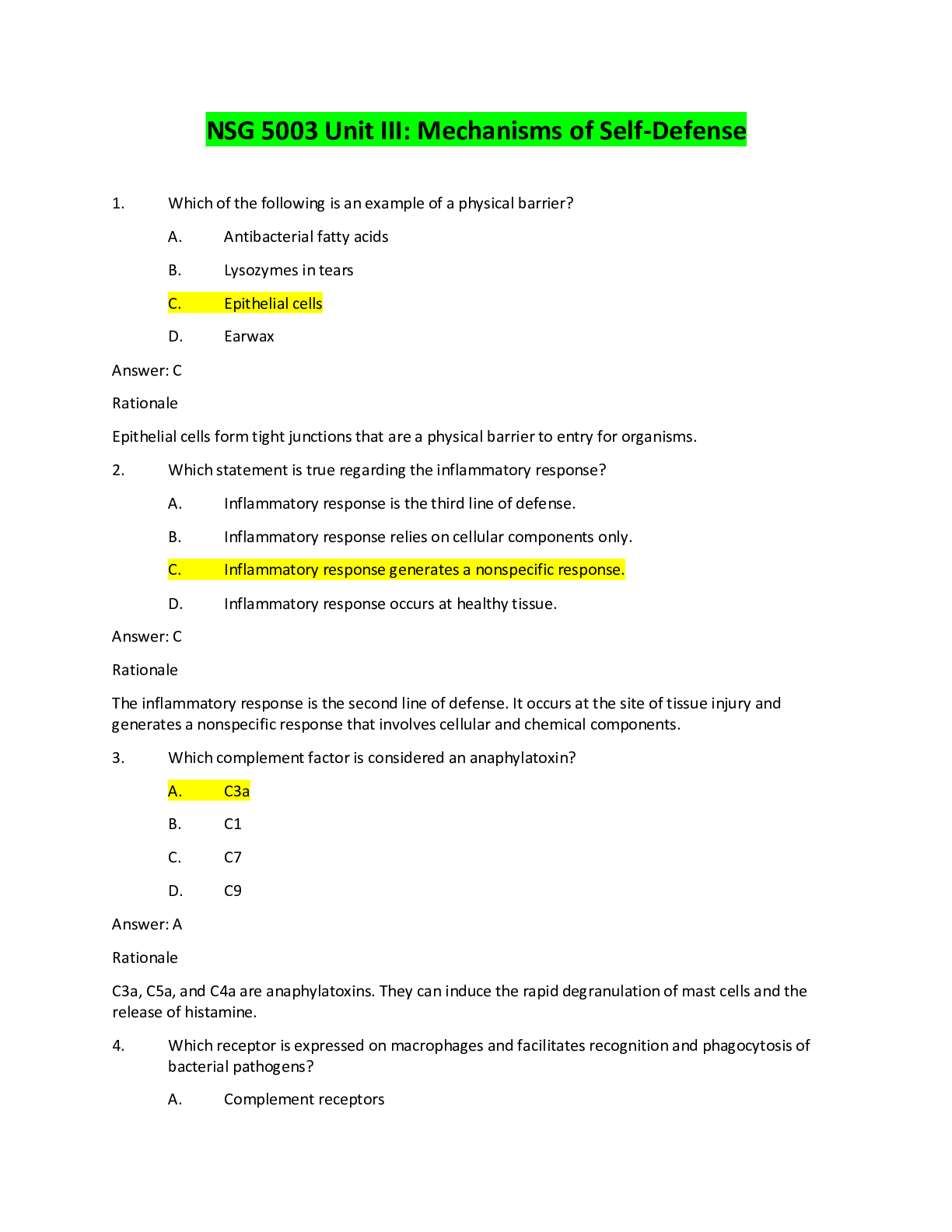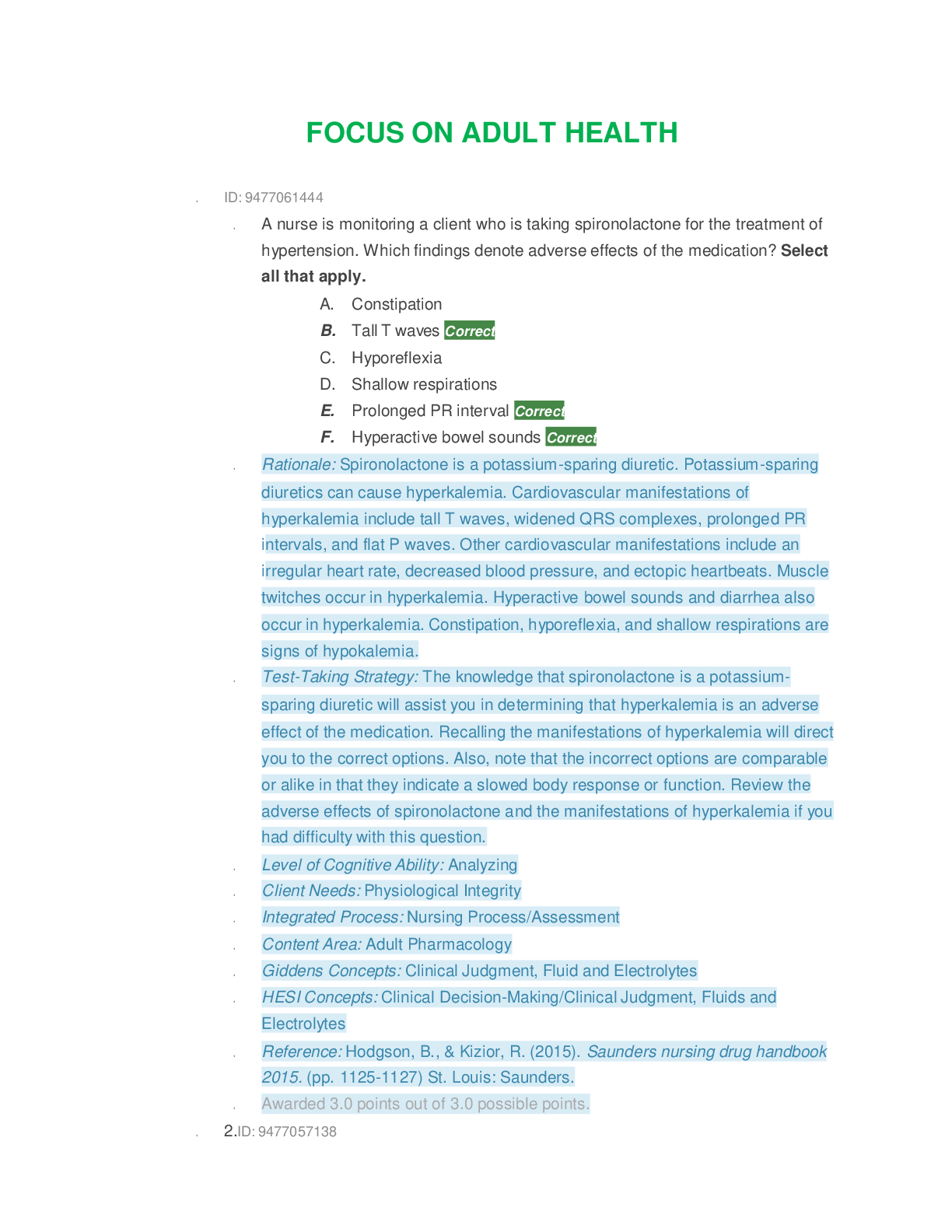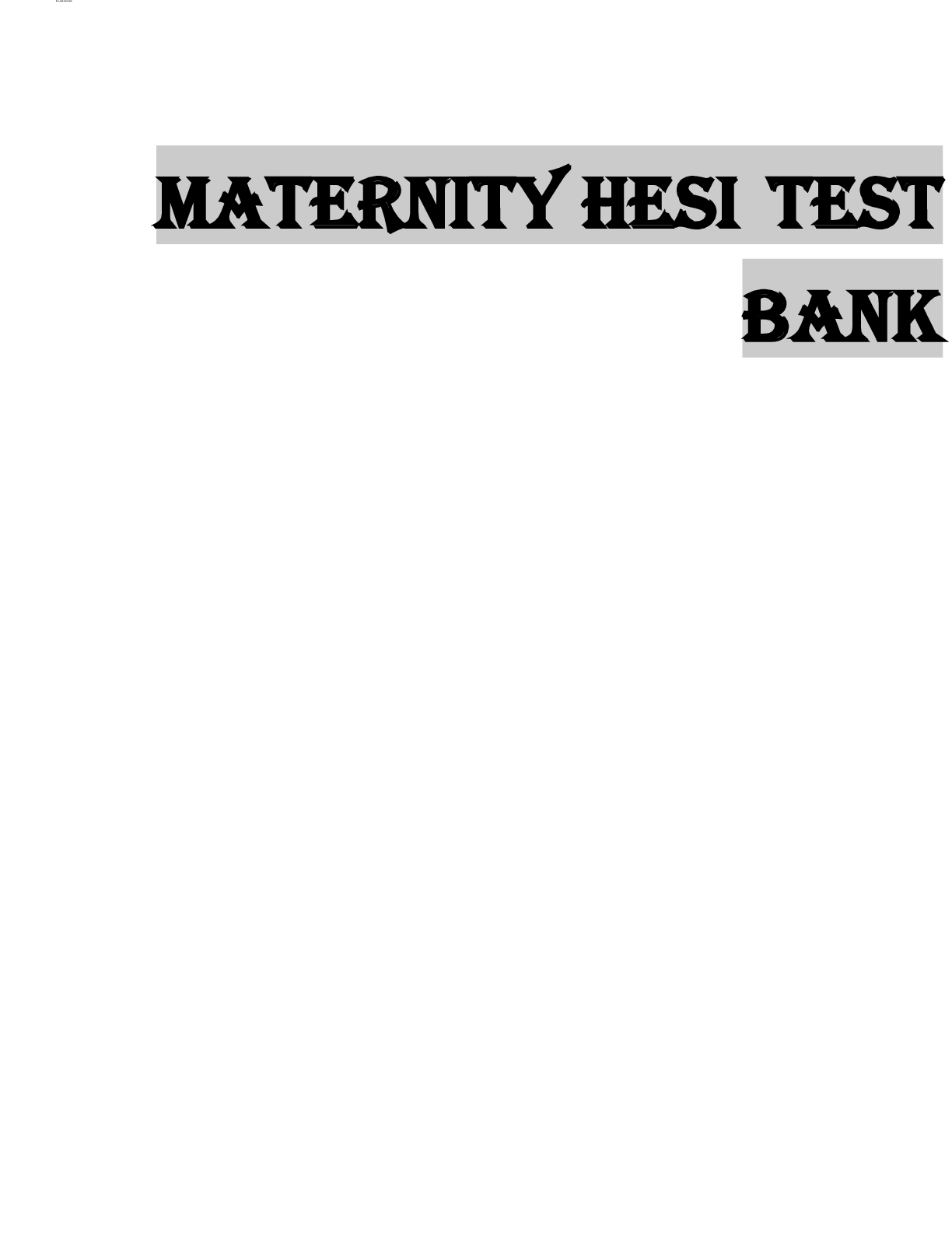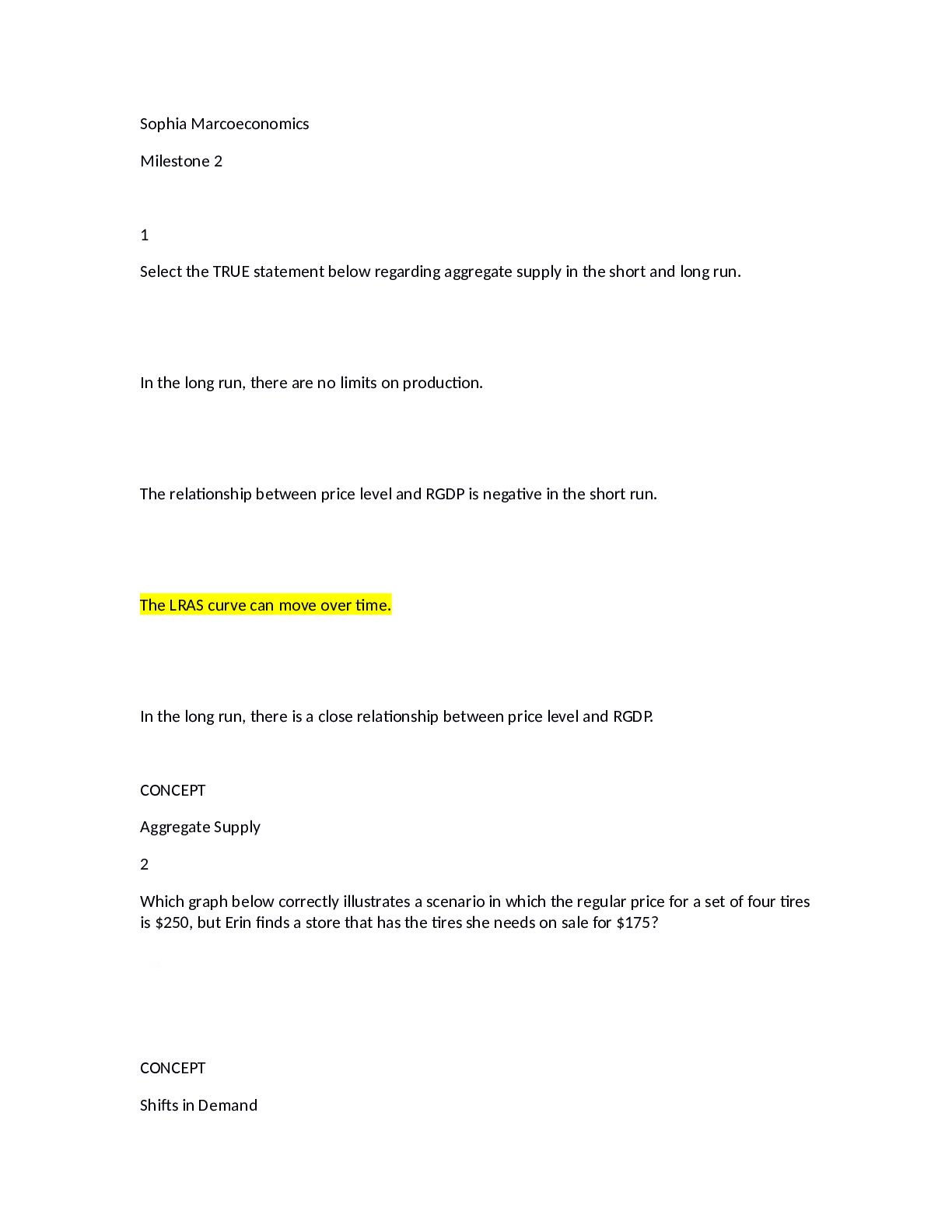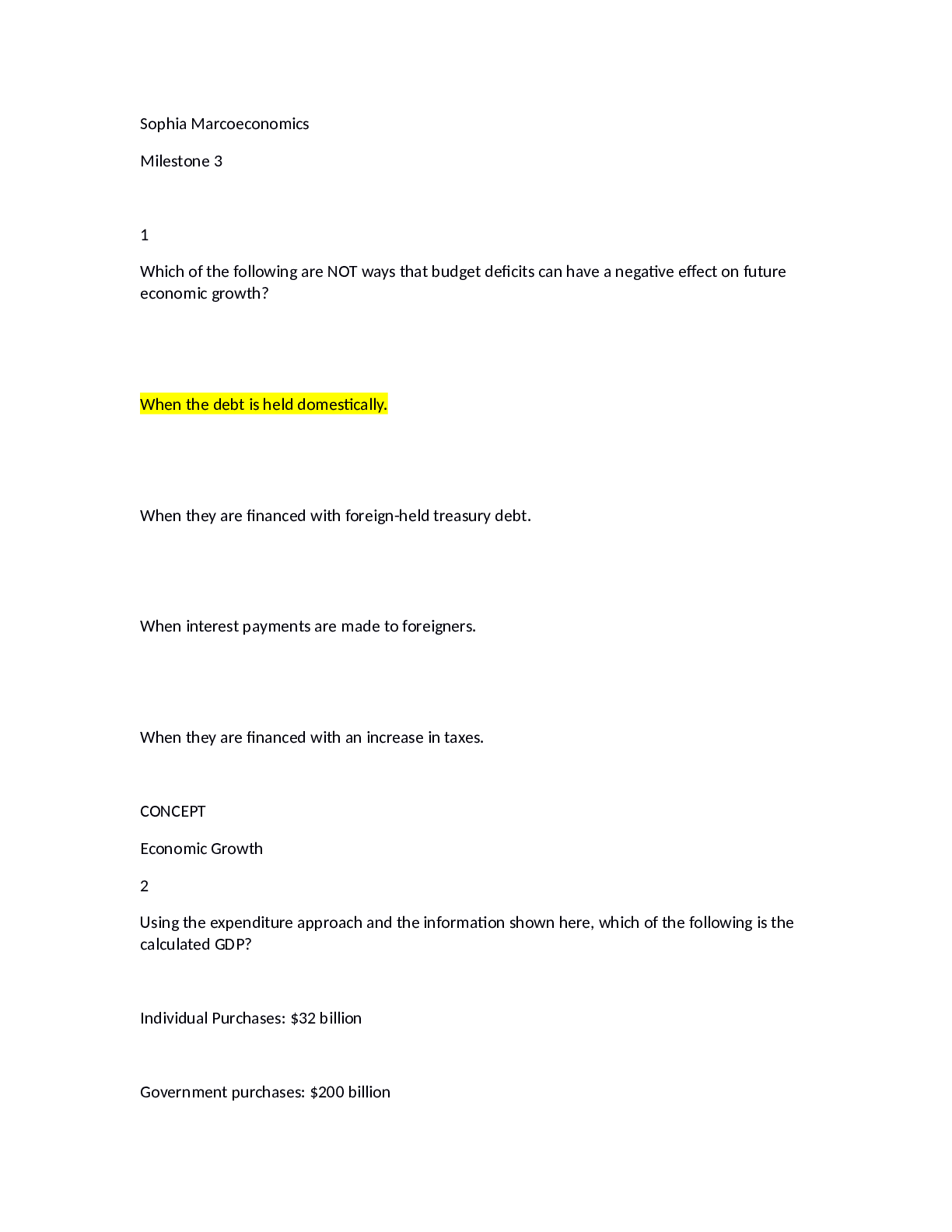2023/2024 MATERNITY HESI TEST BANK - QUESTIONS, ANSWERS AND RATIONALES
Document Content and Description Below
2023/2024 MATERNITY HESI TEST BANK - QUESTIONS, ANSWERS AND RATIONALES A client at 30 weeks of gestation is on bed rest at home because of increased blood pressure. The home health nurse has taught ... her how to take her own blood pressure and gave her parameters to judge a significant increase in blood pressure. When the client calls the clinic complaining of indigestion, which instruction should the nurse provide? A. Lie on your left side and call 911 for emergency assistance. B. Take an antacid and call back if the pain has not subsided. C. Take your blood pressure now, and if it is seriously elevated, go to the hospital. D. See your health care provider to obtain a prescription for a histamine blocking agent. Rationale: Checking the blood pressure for an elevation is the best instruction to give at this time. A blood pressure exceeding 140/90 mm Hg is indicative of preeclampsia. Epigastric pain can be a sign of an impending seizure (eclampsia), a life-threatening complication of gestational hypertension. Additional data are needed to confirm an emergency situation as described in option A. Options B and D ignore the threat to client safety posed by a significant increase in blood pressure. The nurse is counseling a couple who has sought information about conceiving. The couple asks the nurse to explain when ovulation usually occurs. Which statement by the nurse is correct? A. Two weeks before menstruation B. Immediately after menstruation C. Immediately before menstruation D. Three weeks before menstruation Rationale: Ovulation occurs 14 days before the first day of the menstrual period. Although ovulation can occur in the middle of the cycle or 2 weeks after menstruation, this is only true for a woman who has a perfect 28-day cycle. For many women, the length of the menstrual cycle varies. Options B, C, and D are incorrect. A client in active labor is becoming increasingly fearful because her contractions are occurring more often than she had expected. Her partner is also becoming anxious. Which of the following should be the focus of the nurse's response? A. Telling the client and her partner that the labor process is often unpredictable B. Informing the client that this means she will give birth sooner than expected C. Asking the client and her partner if they would like the nurse to stay in the room D. Affirming that the fetal heart rate is remaining within normal limits Rationale: Offering to remain with the client and her partner offers support without providing false reassurance. The length of labor is not always predictable, but options A and B do not offer the client the support that is needed at this time. Option D may be reassuring regarding the fetal heart rate but does not provide the client the emotional support she needs at this time during the labor process. When assessing a client at 12 weeks of gestation, the nurse recommends that she and her husband consider attending childbirth preparation classes. When is the best time for the couple to attend these classes? A. At 16 weeks of gestation B. At 20 weeks of gestation C. At 24 weeks of gestation D. At 30 weeks of gestation Rationale: Learning is facilitated by an interested pupil. The couple is most interested in childbirth toward the end of the pregnancy, when they are beginning to anticipate the onset of labor and the birth of their child. Option D is closest to the time when parents would be ready for such classes. Options A, B, and C are not the best times during a pregnancy for the couple to attend childbirth education classes. At these times they will have other teaching needs. Early pregnancy classes often include topics such as nutrition, physiologic changes, coping with normal discomforts of pregnancy, fetal development, maternal and fetal risk factors, and evolving roles of the mother and her significant others. The nurse is evaluating a full-term multigravida who was induced 3 hours ago. The nurse determines that the client is dilated 7 cm and is 100% effaced at 0 station, with intact membranes. The monitor indicates that the FHR decelerates at the onset of several contractions and returns to baseline before each contraction ends. Which action should the nurse take? A. Reapply the external transducer. B. Insert the intrauterine pressure catheter. C. Discontinue the oxytocin infusion. D. Continue to monitor labor progress Rationale: The fetal heart rate indicates early decelerations, which are not an ominous sign, so the nurse should continue to monitor the labor progress and document the findings in the client's record. There is no reason to reapply the external transducer if the FHR tracings are being captured. Options B and C are not indicated at this time. The nurse instructs a laboring client to use accelerated blow breathing. The client begins to complain of tingling fingers and dizziness. Which action should the nurse take? A. Administer oxygen by facemask. B. Notify the health care provider of the client's symptoms. C. Have the client breathe into her cupped hands. D. Check the client's blood pressure and fetal heart rate. Rationale: Tingling fingers and dizziness are signs of hyperventilation (blowing off too much carbon dioxide). Hyperventilation is treated by retaining carbon dioxide. This can be facilitated by breathing into a paper bag or cupped hands. Option A is inappropriate because the carbon dioxide level is low, not the oxygen level. Options B and D are not specific for this situation. Which maternal behavior is the nurse most likely to see when a new mother receives her infant for the first time? A. She eagerly reaches for the infant, undresses the infant, and examines the infant completely. B. Her arms and hands receive the infant and she then traces the infant's profile with her fingertips. C. Her arms and hands receive the infant and she then cuddles the infant to her own body. D. She eagerly reaches for the infant and then holds the infant close to her own body. Rationale: Attachment and bonding theory indicates that most mothers will demonstrate behaviors described in option B during the first visit with the newborn, which may be at delivery or later. After the first visit, the mother may exhibit different touching behaviors such as eagerly reaching for the infant and cuddling the infant close to her A 25-year-old client has a positive pregnancy test. One year ago she had a spontaneous abortion at 3 months of gestation. Which is the correct description of this client that should be documented in the medical record? A. Gravida 1, para 0 B. Gravida 1, para 1 C. Gravida 2, para 0 D. Gravida 2, para 1 Rationale: This is the client's second pregnancy or second gravid event, so option C is correct. The spontaneous abortion (miscarriage) occurred at 3 months of gestation (12 weeks), so she is a para 0. Parity cannot be increased unless delivery occurs at 20 weeks of gestation or beyond. Option A does not take into account the current pregnancy, nor does option B, which also counts the miscarriage as a "para," an incorrect recording. Although option D is correct concerning gravidity, para 1 is incorrect. Just after delivery, a new mother tells the nurse, "I was unsuccessful breastfeeding my first child, but I would like to try with this baby." Which intervention should the nurse implement first? A. Assess the husband's feelings about his wife's decision to breastfeed their baby. B. Ask the woman to describe why she was unsuccessful with breastfeeding her last child. C. Encourage the woman to develop a positive attitude about breastfeeding to help ensure success. D. Provide assistance to the mother to begin breastfeeding as soon as possible after delivery. Rationale: Infants respond to breastfeeding best when feeding is initiated in the active phase soon after delivery. Options A and B might provide interesting data, but gathering this information is not as important as providing support and instructions to the new mother. Although option C is also true, this response by the nurse might seem judgmental to a new mother. A primigravida, when returning for the results of her multiple marker screening (triple screen), asks the nurse how problems with her baby can be detected by the test. What information will the nurse give to the client to describe best how the test is interpreted? A. If MSAFP (maternal serum alpha-fetoprotein) and estriol levels are high and the human chorionic gonadotropin (hCG) level is low, results are positive for a possible chromosomal defect. B. If MSAFP and estriol levels are low and the hCG level is high, results are positive for a possible chromosomal defect. C. If MSAFP and estriol levels are within normal limits, there is a guarantee that the baby is free of all structural anomalies. D. If MSAFP, estriol, and hCG are absent in the blood, the results are interpreted as normal findings. Rationale: Low levels of MSAFP and estriol and elevated levels of hCG found in the maternal blood sample are indications of possible chromosomal defects. High levels of MSAFP and estriol in the blood sample after 15 weeks of gestation can indicate a neural tube defect, such as spina bifida and anencephaly, not chromosomal defects. One of the limitations of the multiple marker screening is that any defects covered by skin will not be evident in the blood sampling. After 15 weeks of gestation, there will be traces of MSAFP, estriol, and hCG in the blood sample. During the transition phase of labor, a client complains of tingling and numbness in her fingers and tells the nurse that she feels like she is going to pass out. What action should the nurse take? A. Encourage her to pant between contractions and blow with contractions. B. Coach her to take a deep cleansing breath and then refocus. [Show More]
Last updated: 7 months ago
Preview 1 out of 53 pages
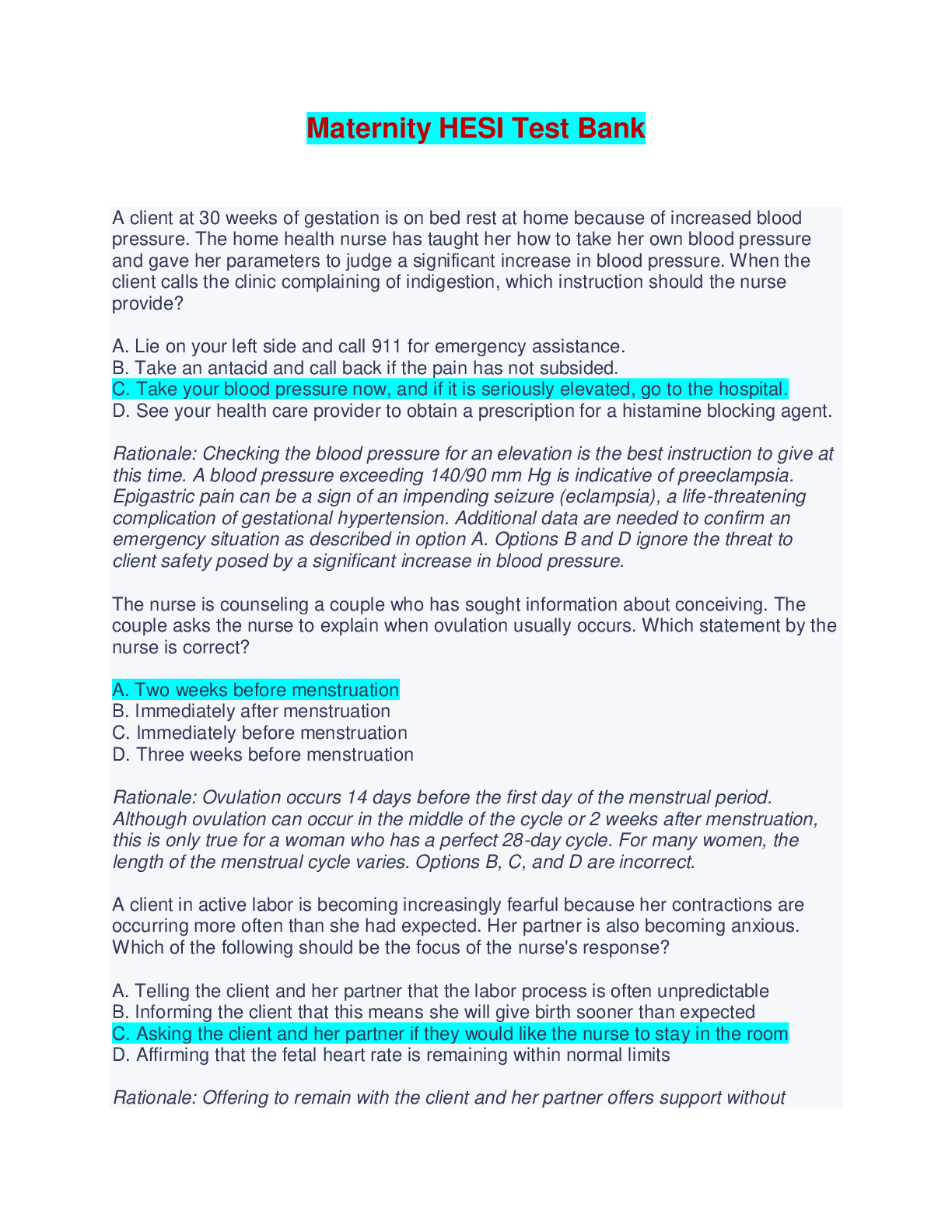
Buy this document to get the full access instantly
Instant Download Access after purchase
Add to cartInstant download
We Accept:

Reviews( 0 )
$20.00
Document information
Connected school, study & course
About the document
Uploaded On
Nov 24, 2023
Number of pages
53
Written in
Additional information
This document has been written for:
Uploaded
Nov 24, 2023
Downloads
0
Views
72



